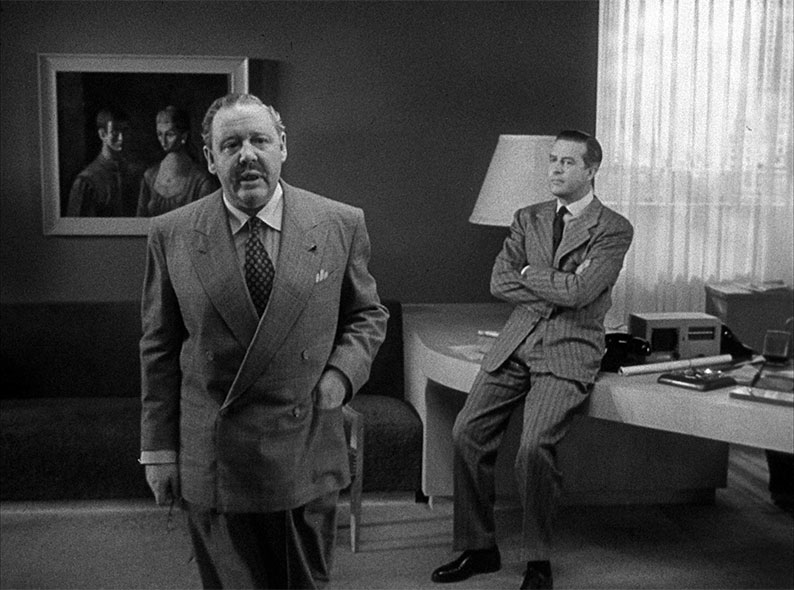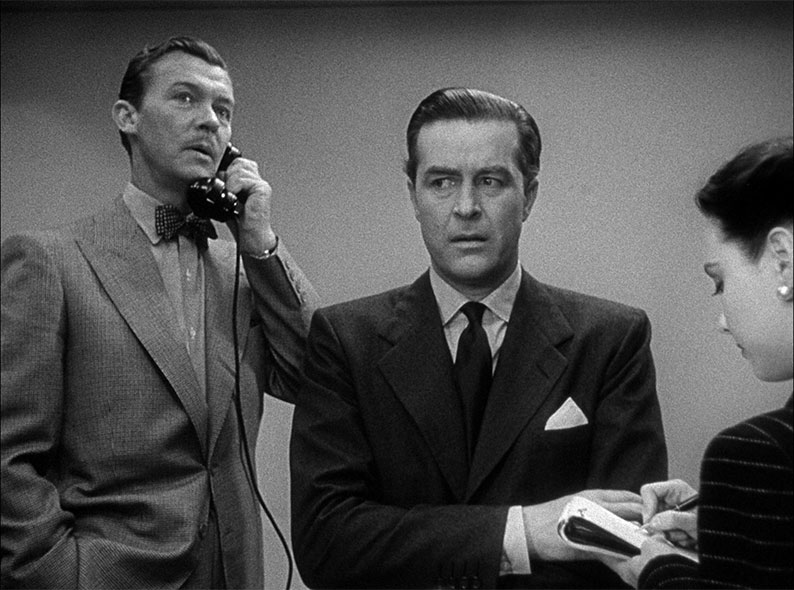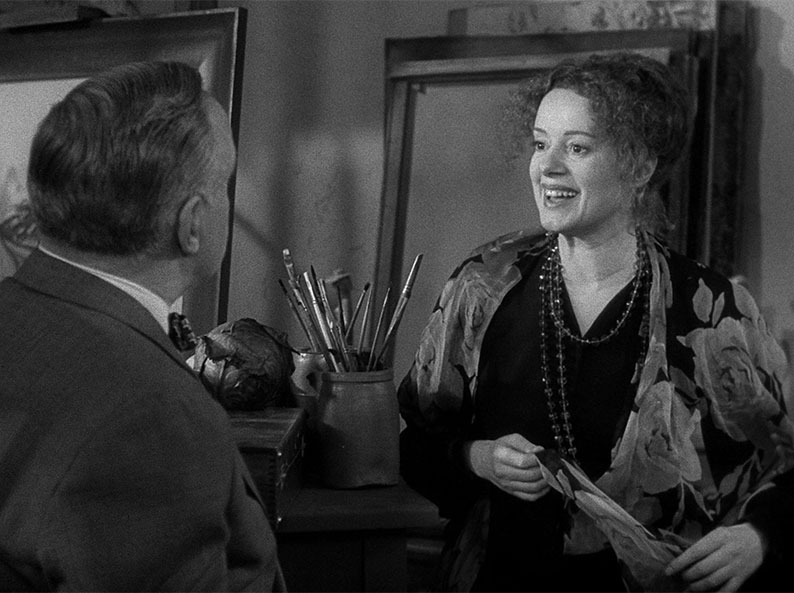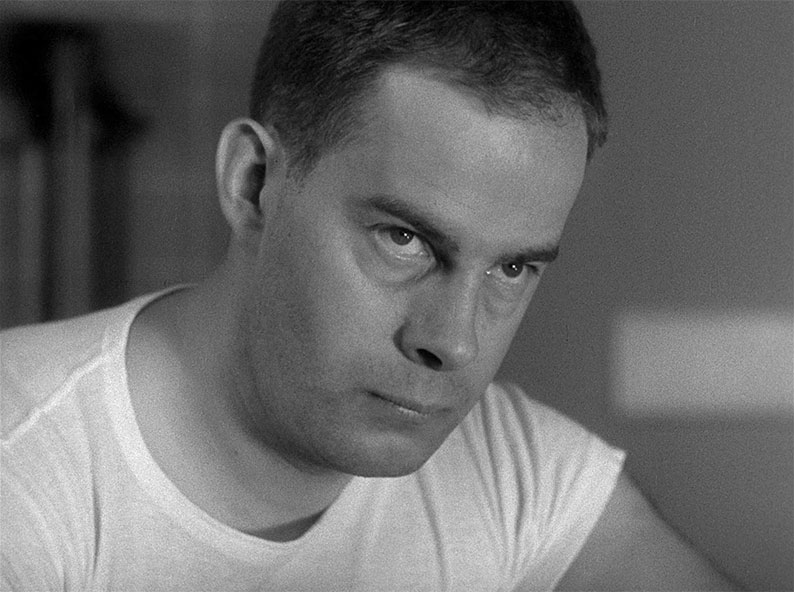Three day bender with Ray Milland
Scotch and soda and candied yams
Things they were getting out of hand
Ray was dancing with the Kerosene Man |
| Steve Wynn – Kerosene Man* |
Okay, confession time. The above quoted lyrics have nothing to do with the film under review, aside from a mention of the leading man's name. I just like the song and have been itching put that particular verse at the head of a review for a couple of years. The film it does have a tenuous link to, of course, is Billy Wilder's The Lost Weekend, in which Ray Milland played alcoholic Don Birnam, but I never got to review that disc, so I'm throwing the quote up here instead. As it happens, I do remember The Lost Weekend having an impact on me in my youth, but by then I was already a bit of a fan of Milland and specifically his performance in Alfred Hitchcock's Dial M for Murder. Milland was a delight there as Tony Wendice, a successful tennis player who plots the murder of his unfaithful wife Margot, then attempts to frame her for the killing of her would-be assassin when the organised attempt on her life goes awry (Ray, of course, would never do the deed himself). What always got me about his performance is that although our sympathies are firmly with Margot (played as she is by the delectable Grace Kelly), there's something so appallingly irresistible about Tony's easy charm and his self-confident attempts to outwit with investigating officer, Chief Inspector Hubbard (an equally lovely John Williams), that just occasionally my loyalties switch and I don't want to see him get caught. Of course, this is exactly how people like Tony get away with so much. "You're accusing Lord Fotherington of the crime? Are you mad? He's greatly respected in these parts, you know, and a man on considerable influence. Why, with a single phone call he could have your job!"
In The Big Clock, Milland plays George Stroud, the editor-in-chief for Crimeways magazine, who as the film opens is clearly in a whole heap of trouble and we don't know why. He's sneaking around and hiding from patrolling security guards, eventually taking refuge in the Big Clock of the title, the electrically powered centrepiece of the Crimeways offices that has never once stopped and whose interior looks almost like the engine room of a small starship. We're clued in to the fact that George is in big trouble by his thoughts voice-over, but not to how he ended up in this mess or even what the mess is.

Flashback 36 hours and George is on his way to his office and just everyone is trying to attract his attention, but he's most interested in a phone call that confirms that one of his operatives has tracked down a man they've been desperately seeking for a potentially circulation-boosting front-page story. It's because of this that he's late for a staff meeting chaired by tyrannical publishing tycoon Earl Janoth (Charles Laughton), who is so pleased with George's accomplishment that he insists he follow the story up personally. George, however, has promised his wife Georgette (Maureen O'Sullivan) and young son George Jr. (B.G. Norman) that they are finally going on the honeymoon vacation that his job has kept him from taking since he and Georgette were first married. He thus flatly refuses, whereupon Janoth promptly gives him the boot.
Before I move on, I have to address the issue of the Stroud family names. Our leading man is George, a common enough moniker in the 1940s, but I have to wonder what the chances were of him falling in love and marrying a woman whose name is Georgette, which is technically the feminine form of his own name. Then they have a son and what do they name him? The name him George. Giving an entire family the same first name might be an amusing gag in a comedy, but seems on face value a somewhat odd little quirk for a thriller, albeit one whose screenplay bristles with witty exchanges and flashes of black humour. As it happens, the film is being faithful to Kenneth Fearing's source novel, where the husband and wife are also named George and Georgette and their young daughter is named Georgia, a child that for unknown reasons has undergone a gender change for the film. On his commentary track, Adrian Turner also picks up on this, and suggests that it was intended as a commentary on conformity and how the individual becomes an anonymous cog in the corporate machine, a theme that was dear to Fearing's heart and indeed is central to the novel.
But I digress. Before heading home, our George – adult George – is lured to a bar by Pauline York (Rita Johnson), with whom Janoth is having a secret affair and to whom he is making regular hush money payments, but who now has a plan to blackmail him for considerably more, a scheme she invites the newly fired George to come in on. George is not interested, but the two get so caught up in their drinking that he misses his holiday train and Georgette and George Jr. head for West Virginia without him. Resigned to his fate, George spends the evening drinking and cavorting around the neighbourhood with Pauline instead and ends up in a drunken daze at her apartment, but is hushed out by her just before Janoth pops up to pay her a visit. Janoth's brief glimpse of the anonymous departing figure starts a heated argument between him and Pauline, and when Pauline pours scorn on her lover's manhood, he loses his temper and strikes her over the head with a metal sundial (another clock) that George bought from the owner of his favourite bar earlier that evening. Realising he has killed her, Janoth heads straight to the home of his fiercely loyal assistant, Steve Hagen (George Macready) and tells him what he has done. Hagen talks him out of going to the police and suggests instead that they shift the blame onto the unidentified man Janoth saw leaving the apartment as he arrived. Wanting to put their best man on the job, Hagen and Janoth call George and press him to take charge of the manhunt, an assignment he initially refuses but is reluctantly forced to accept when he realises that the person that they are looking for is him.

It's a really neat setup that places George in an impossible position, one that the opening sequence has already confirmed will eventually blow up in his face. Obviously, the last thing George wants to do is identify himself as the man seen leaving Pauline's apartment, but as the paper's best investigator he is expected to approach the task with his usual zeal, particularly as almost all of the paper's staff have been reassigned to assist him. Leads are thus followed in the hope that they go nowhere harmful, and given the colourful evening George and Pauline spent leading up to the killing, there are plenty to chase up. Repeatedly it looks as if it will be revealed that the man they are looking for is not Jefferson Randolph – a false name given to Janoth by Pauline – but George himself, only for witnesses to struggle to accurately recall details, be temporarily unavailable or – as in the case of the barman at George's regular watering hole – frustrate the investigation but giving a hapless and soon to be fired reporter a description so preposterous that it sets eyes rolling when the daft sod phones it into the office. The ante is upped when Pauline is identified as the woman who was with Randolph that evening and George sneaks into her apartment and finds her dead body on the floor, and further still when Janoth decides it would be better if Randolph was not found but quietly disposed of.
The Big Clock has found itself intermittently badged as a noir thriller, and legitimate though this label is the film is actually a melding of several genres, with some earlier scenes even having the pace and banter of a screwball comedy (a characteristic repeatedly highlighted in this disc's special features) – it's only once the noose starts to tighten around George's neck that the film really earns its thriller credentials. It's also here that the complexity and sophistication of Jonathan Latimer's consistently sharp and often witty script really shows its colours, as seemingly every action taken by George in the first half starts to have a bearing on how quickly the true identity of the mysterious Jefferson Randolph might be revealed. This builds to an almost dizzying game of cat-and-mouse when George is briefly spotted in the publishing house by someone with whom he had dealings the previous evening, and the building is put immediately on lockdown and a posse of witnesses brought in to sweep the offices in an effort to identify the man in question, forcing George to take increasingly desperate evasive action.
John Farrow directs with purpose and a precise control of his story and his camera, marshalling every thread of the multi-stranded narrative with a clarity that ensures we are never left uncertain by any aspect of the investigation or forget who is who when they reappear later as witnesses to earlier events. His use of long takes and sometimes (subtly) complex camera moves sits comfortably alongside an almost Wellesian arrangement of multiple figures in a frame and a striking use of facial close-ups to convey extreme emotion and suggest intent. This is at its most unnerving when Janoth calmly suggests to his personal henchman Bill Womack (Harry Morgan), who is in the process of massaging his boss (one aspect of a gay subtext that was more open in the novel, where Pauline is described at one point as "beautiful if you like Lesbians in standard, Park Avenue models"), that it might be handy if someone were to shoot this fellow Randolph in the back, and Womack stares ahead with an expression into which you could read a small and rather frightening novel.

Farrow's work with the actors is also worthy of note. Milland is shrewdly cast here, his likeable demeanour and cheerful refusal to be bullied by Janoth's threat to fire and blacklist him making it oddly easy to turn a blind eye to the fact that when he misses the train to West Virginia, instead of heading straight to the airport (as he later does) and flying there instead, he hits the town with a beautiful woman and ends up drunk and unconscious back at her apartment. Charles Laughton makes for a splendidly self-assured and pompously superior Janoth, a man given to accompanying decisions and comments with an almost unconscious stroke of his moustache and having employees coldly dismissed on the spot for the smallest infraction. The inimitable George Macready is appropriately stoic as Janoth's coolly protective right-hand man, Steve Hagan, and Henry (later Harry) Morgan – who later found popular fame as Colonel Potter in the TV version of M*A*S*H – is genuinely sinister as the always silent Bill Womack, the only member of Janoth's staff who appears to suspect George from an early stage. Either that or he harbours a secret hatred for the man. Best of all, however, is the wonderful Elsa Lanchester in a small but scene-stealing role as eccentric artist Louise Patterson, who giggles hilariously when nervous or surprised and is cheerfully open to bribery if the price is right. She also delivers one of my favourite lines in the film, when a reporter turns up at her door to interview her and she recalls that he once reviewed one of shows. "Oh, come in!" she says cheerfully, "I've been planning to kill you for years!"
Framed in its original 1.37:1 aspect ratio, the transfer here, which was restored from the original film elements, is generally in fine shape, but with a few small caveats, doubtless due the condition of the source material. The image at its best is very impressive – some of the facial close-ups are arrestingly rendered – with sharply defined detail and well-balanced contrast, though this does vary a little in intensity and is stronger in some scenes than it is in others. The black levels, as you would hope for a noir-tinted film, are solid throughout, though do suck in a little of the surrounding detail in those higher contrast shots. There are still some visible traces of former damage and some flickering visible at times, and on a couple of sequences this is impossible to ignore. The film grain is also clearly evident and slightly coarser here than on some films of this era, but this is still a very good transfer for the most part, and as I said earlier, the best material is in excellent shape, and there's a lot of that.

The Linear PCM 1.0 mono soundtrack does show its age, notably in the faintly audible background fluff and the expected restrictions in the dynamic range, but the dialogue and music are both clear and there are no pops or crackle of damage to contend with.
Optional English subtitles for the hearing impaired are included.
Audio Commentary by Adrian Martin
This new commentary by learned film scholar Adrian Martin impressively expanded on my appreciation of a film that Martin states up front is "outstanding and endlessly fascinating," a claim he then goes on to justify in persuasive detail. Areas covered include Farrow's use of long takes and perfectly timed edits, the crypto-gay undertones, the screwball comedy elements, the underlying themes, the cast, the filmmakers, and a whole lot more. Useful comparisons are made between the film and Kenneth Fearing's source novel, from which enticing extracts are read (it really is worth hunting out if you can find a copy), and as noted above, the issue of the family full of Georges is broached and given plausible justification. The only point on which I have to disagree with Mr. Martin is his analysis of the complexity of the early shot set in an elevator interior, which stops at several floors, each of which have different decor to the one the preceded it. Martin salutes the complexity of having to repeatedly and rapidly change the set outside the elevator before the doors open, but the tell-tale signs are there that these were not sets at all, but back-projected footage. Effective still, but not quite as complex to pull off.
Turning Back the Clock (23:01)
This newly shot analysis of The Big Clock by the critic and chief executive of Film London, Adrian Wooton, is another most worthy companion to the film, though it does include enough spoilers to be treated as after-film viewing, not an introduction to it. Wooton highlights the work of novelist Kenneth Fearing, screenwriter Jonathan Latimer, cinematographer John Seitz and director John Farrow, notes that Charles Laughton was at this time specialising in playing repugnant but fascinating characters, and sings the praises of Elsa Lanchester's performance. He also picks up on the screwball comedy elements, discusses some of the key differences between the novel and the screenplay, and does briefly talk about the 1987 remake, No Way Out. I was starting to wonder if anyone was going to give that film a mention.
A Difficult Actor (17:31)
Actor, writer, theatre director and Charles Laughton biographer Simon Callow provides a new appreciation of Laughton and his performance in The Big Clock, starting ominously with the claim that this was a dispiriting period of the actor's career, then cheerily championing this particular film and Laughton's performance in it. An enjoyable extra.

Lux Radio Theatre: The Big Clock (59:28)
A rare hour-long 1948 radio dramatization of the Big Clock by the Lux Radio Theatre, starring Ray Milland and Maureen O'Sullivan. Once you get past the promotional blather for Lux Toilet Soap, this radio adaptation inevitably compresses the hell out the movie and loses almost all of its nuance and a fair deal of its complexity (not to mention most of what makes it work so well as a film), but is energetically performed and certainly easy to follow. It's interrupted 21 minutes in by a vacuous "news about the stars" spot that mutates horribly into another overlong promo for Lux Toilet Soap, and again 41 minutes in for a guest appearance from a Columbia studio hairstyle supervisor that inevitably does likewise. In case you missed them, there's another push for this soapy product at the very end of the show. The audio is accompanied by stills from the film, which are slowly zoomed in on to avoid screen burn on plasma and OLED TVs.
Theatrical Trailer (2:21)
Ray Milland has a date with suspense! A real surprise this one, as it opens with Milland in front of a radio microphone, accompanied by an announcer and the show director, who unexcitedly assures us (in words being read from the script he is holding) that "suspense is my business." Milland looks on with an air of bored disdain until it's his turn to talk. Film extracts do follow, but this is still an odd trailer.
The Image Gallery is split into two sections – Posters and Press contains 20 slides of international posters and press booklet pages, while Production Stills has a hefty 107 slides of promotional stills.
The first pressing of the disc also comes with an Illustrated Collector's Booklet featuring new writing on the film by Christina Newland, but this was not available for review.
A terrific yet criminally little-seen thriller with comic elements and more than a whiff of noir in John F. Seitz's monochrome cinematography, as well a belter of a cast on fine form, and it gets a strong HD release as part of the Arrow Academy label, with a generally solid transfer and some excellent extras. Highly recommended.
|